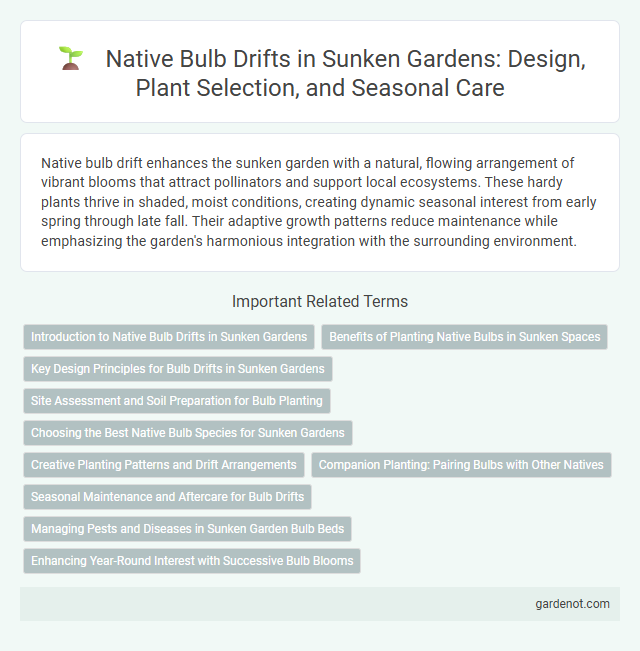Native bulb drift enhances the sunken garden with a natural, flowing arrangement of vibrant blooms that attract pollinators and support local ecosystems. These hardy plants thrive in shaded, moist conditions, creating dynamic seasonal interest from early spring through late fall. Their adaptive growth patterns reduce maintenance while emphasizing the garden's harmonious integration with the surrounding environment.
Introduction to Native Bulb Drifts in Sunken Gardens
Native bulb drifts in sunken gardens create naturalistic clusters of flowering bulbs that enhance seasonal color and biodiversity. These drifts typically include species such as wild daffodils, native bluebells, and trout lilies that thrive in the garden's moist, sheltered microclimate. Incorporating native bulb drifts supports pollinators and reinforces the ecological value of sunken garden designs by mimicking woodland and meadow ecosystems.
Benefits of Planting Native Bulbs in Sunken Spaces
Planting native bulbs in sunken gardens enhances soil stability by reducing erosion through their extensive root systems. These bulbs attract local pollinators, supporting biodiversity and promoting a balanced ecosystem within the confined space. Their natural adaptation to the regional climate ensures low maintenance and resilient growth in the often-moist conditions of sunken areas.
Key Design Principles for Bulb Drifts in Sunken Gardens
Key design principles for native bulb drifts in sunken gardens emphasize naturalistic patterns that mimic local ecosystems, enhancing ecological harmony and aesthetic appeal. Prioritize planting clusters of native species such as Camassia, Erythronium, and Allium bulbs in undulating drifts to create seasonal interest with minimal maintenance. Soil preparation and appropriate spacing ensure healthy bulb growth, while layering bloom times maximizes visual impact throughout spring and early summer.
Site Assessment and Soil Preparation for Bulb Planting
Site assessment for native bulb drift involves evaluating soil composition, drainage, and sunlight exposure to ensure optimal growth conditions. Soil preparation requires loosening the soil to a depth of 8-12 inches, incorporating organic matter such as compost to enhance fertility and moisture retention. Proper pH balance--typically between 6.0 and 7.0--is essential to support native bulb development and maximize blooming potential in sunken garden environments.
Choosing the Best Native Bulb Species for Sunken Gardens
Selecting the best native bulb species for sunken gardens involves prioritizing plants that thrive in partial shade and well-drained, moisture-retentive soils common to these unique landscapes. Species such as Camassia leichtlinii, wild tulips (Tulipa species), and the native wild daffodil (Narcissus pseudonarcissus) offer vibrant seasonal color while supporting local pollinators and maintaining ecological balance. Focusing on native bulbs enhances sustainability, reduces maintenance needs, and ensures harmonious integration with the sunken garden's microclimate.
Creative Planting Patterns and Drift Arrangements
Native bulb drift arrangements enhance the sunken garden's natural aesthetic by grouping species like Camassia, Trillium, and Erythronium in fluid, expansive clusters that mimic wild growth patterns. Creative planting patterns emphasize varying bloom times and heights to maintain continuous visual interest and biodiversity throughout seasons. Integrating native bulbs into layered drifts supports pollinator activity while creating dynamic, textural contrasts within the garden's sunken design.
Companion Planting: Pairing Bulbs with Other Natives
Native bulb drift thrives in sunken gardens by pairing bulbs like Camassia and Trillium with complementary native perennials such as Echinacea and Rudbeckia, enhancing ecological balance and visual continuity. Companion planting supports soil health and encourages pollinator activity by creating diverse layers of bloom throughout the growing season. This method reduces maintenance needs and fosters a resilient, thriving native plant community in sunken garden settings.
Seasonal Maintenance and Aftercare for Bulb Drifts
Native bulb drift requires seasonal maintenance to ensure healthy growth and vibrant blooms each year. Regular removal of spent foliage and deadheading prevents disease and encourages bulb replenishment, while applying mulch retains moisture and suppresses weeds. Aftercare includes dividing overcrowded bulbs every few years to maintain flowering density and soil fertility.
Managing Pests and Diseases in Sunken Garden Bulb Beds
Effective management of pests and diseases in native bulb drift beds within the sunken garden is crucial for maintaining vibrant blooms. Implementing integrated pest management techniques, such as regular monitoring for bulb rot and fungal infections, helps preserve plant health. Utilizing organic treatments and ensuring proper soil drainage reduces disease incidence and supports sustainable bulb growth.
Enhancing Year-Round Interest with Successive Bulb Blooms
Native bulb drift techniques create continuous visual appeal in sunken gardens by staggering bloom times of various species such as Camassia, Trillium, and Erythronium. Selecting bulbs with successive flowering periods ensures a dynamic, evolving landscape from early spring through late summer, maximizing seasonal interest. This method supports biodiversity and attracts pollinators, strengthening the ecological health of the garden space.
Native bulb drift Infographic

 gardenot.com
gardenot.com